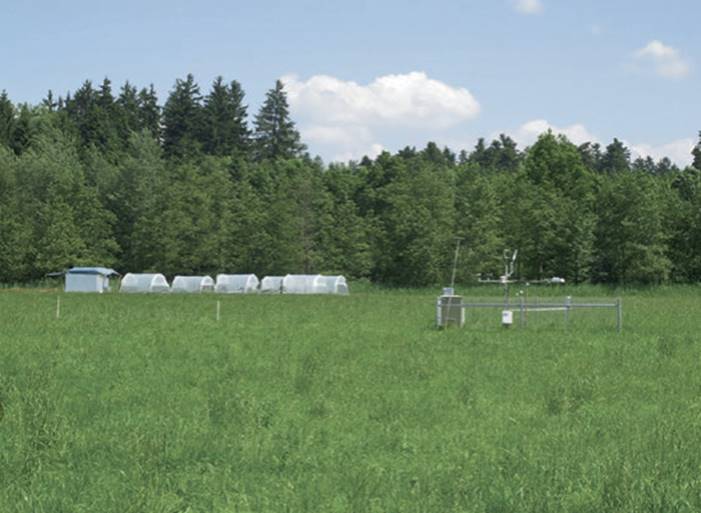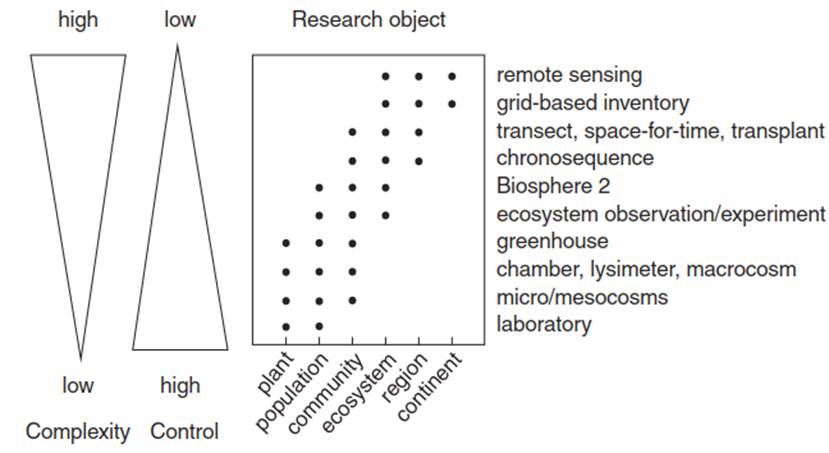Approaches to Study Terrestrial Ecosystems
One can study terrestrial ecosystems in many ways: as an attentive observer, as an experimentalist designing hypothesis-driven experiments, or as a modeller. Depending on the research questions asked and where the focus of this system- oriented and often also process-oriented research is, one not only carries out measurements of biogeochemical pools and fluxes but also quantifies responses of individual species and plant communities to changes in environmental conditions, plant diversity or ecosystem management. Studies can be short-term or long-term; they can be carried out at a single site or can rely on multiple sites. However, all of these different approaches, measurements and/or models need to account for the ecosystem characteristics mentioned in Chap. 13.

Thus, the methodology used to study terrestrial ecosystems is often based on many different disciplines (e.g. biology, soil science, hydrology and micrometeorology) and is typically used in combination (e.g. measurements of biospheric- atmospheric gas exchange of entire ecosystems). This leads to interdisciplinary research, which demands solid disciplinary background knowledge but also interest and skills in interacting with neighbouring disciplines.
Which measurements are taken when, where and how often depends on the research question:
- If one is interested in the effect of drought on water use in a grassland, then different water supplies to this grassland need to be taken into account—that is, precipitation, soil water storage, groundwater and maybe even irrigation. Thus, measurements of climatic variables such as precipitation and temperature, but also soil moisture, evapotranspiration and stand biomass and architecture, will have to be taken close to the field site (climate) and at the field site (all other variables), including soil profile measurements down to a certain depth, either continuously or in campaign mode before, during and after the drought.
However, if one is interested in the effects of drought on competition for water in a grassland, then the vegetation composition needs to be taken into account as well, in addition to the variables mentioned above. Thus, measurements of growth and ecophysiology will have to be added at species or functional group levels and carried out in campaign mode in the field or in the greenhouse.
Overall, good knowledge of experimental design and statistics is crucial for the study of ecosystems, whether one focuses on observations or experiments.
Furthermore, long-term studies are necessary to separate short-term responses of ecosystems to environmental factors from long-term trends. If one is interested in the impacts of global warming on forest productivity, then short-term responses to a summer heatwave causing water stress in a particular year might counteract a long-term trend of increased productivity. Long time series of multiple decades are needed to separate these short-term signals (sometimes also called noise) from the long-term signal of global warming, particularly when the driver (air temperature) increases only slowly. However, such long-term data are rarely available.
On the other hand, short-term studies, often carried out as campaigns of several days to weeks or as 3-year experiments (the typical funding period), need to take transient effects into account. Such effects occur when environmental conditions have been changed very suddenly in an experiment (e.g. by changing fertilisation or by establishing a new species composition) while the processes under study (e.g. plant growth or soil microbial processes) respond much more slowly in comparison with the change in the driver. For example, plant growth will be related not only to the new fertilisation regime but also to the large pool of nutrients already present in the soil.
Thus, changes in plant growth in response to the new fertilisation regime might not become apparent until much later, when the old pool of soil nutrients is really affected by the new fertilisation. Using chronosequences (i.e. multiple sites subjected to the same driver but at different times) might be the way to go. For the example discussed above, a chronosequence with multiple sites (typically unreplicated) at which fertilistion was changed 1, 3, 6, 9 and 12 years ago might be better suited to study the responses to a change in the fertilisation regime. However, replacing time for space is based on the assumption that conditions were constant over time, which is not always the case.

Fig. 14.1. Different approaches to study terrestrial ecosystems. The approaches described in this chapter differ in complexity and possibility to control for environmental conditions, as well as in their spatial applications
Spatially distributed studies are necessary for generalisation of the findings from otherwise individual case studies. Thus, single sites are part of gradients (typically along environmental drivers or management intensities) or transects (typically across the landscape or across continents), networks or grid-based inventories (Fig. 14.1). Definition of the variables and criteria on which these spatially distributed studies are based is relatively easy (e.g. annual temperature, across Australia, grid size 500 x 500 km). However, quantification of the abiotic and biotic factors that covary with these criteria (e.g. annual precipitation, soil type, elevation and management), and identifying these interactions, is very difficult and thus often limits the applicability of such spatial approaches.
Date added: 2025-02-05; views: 302;
